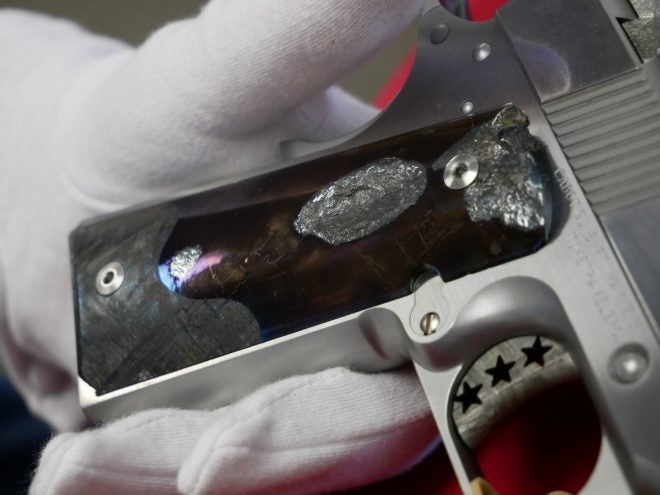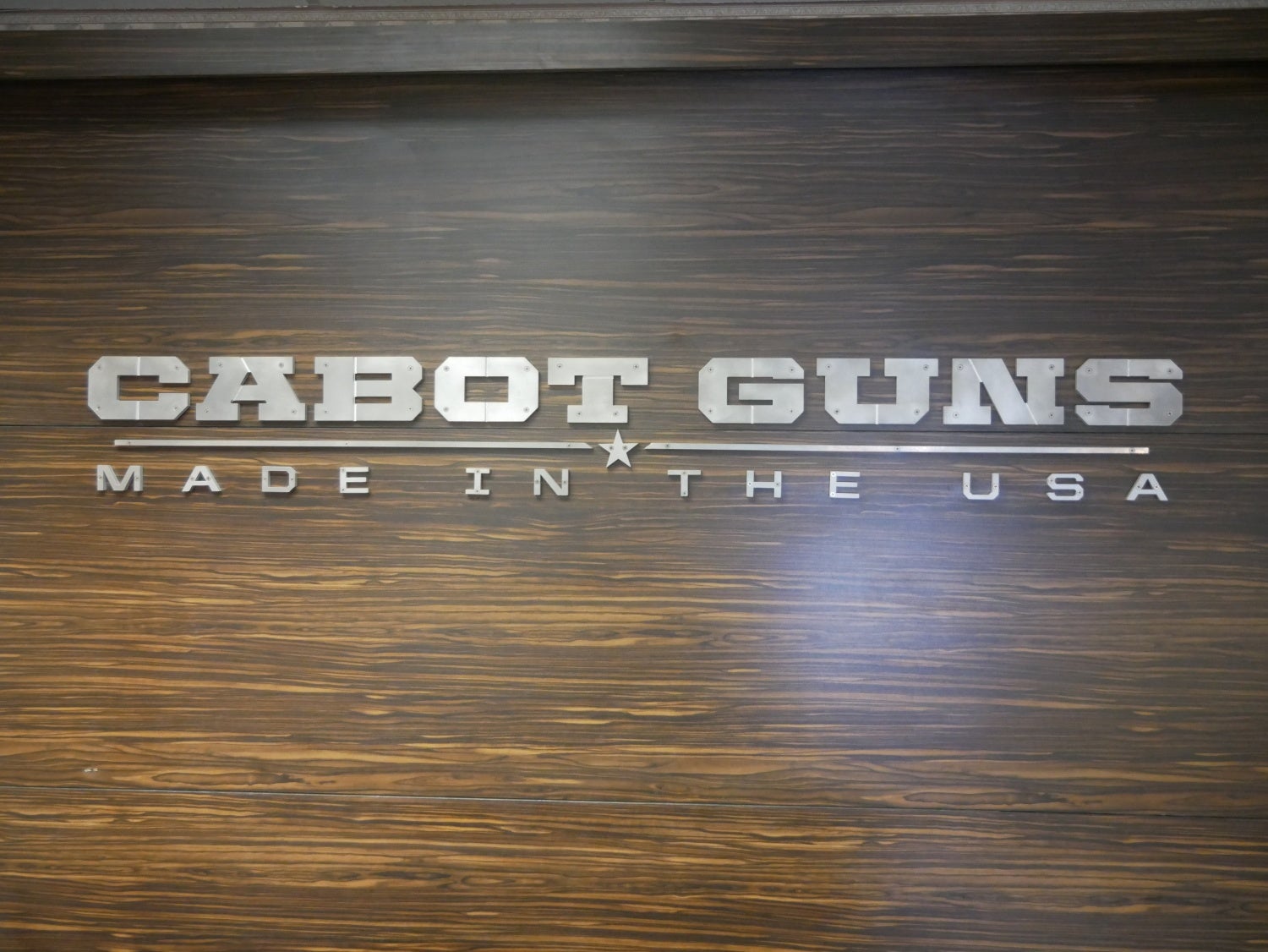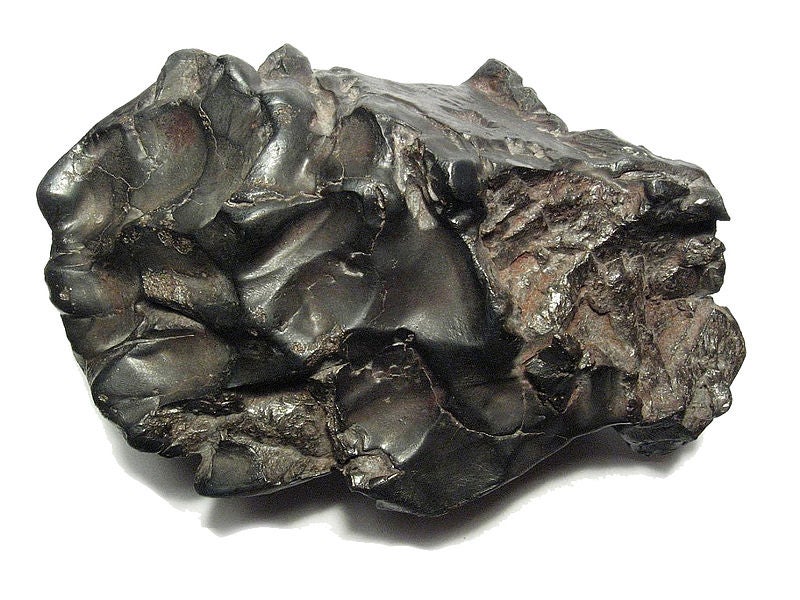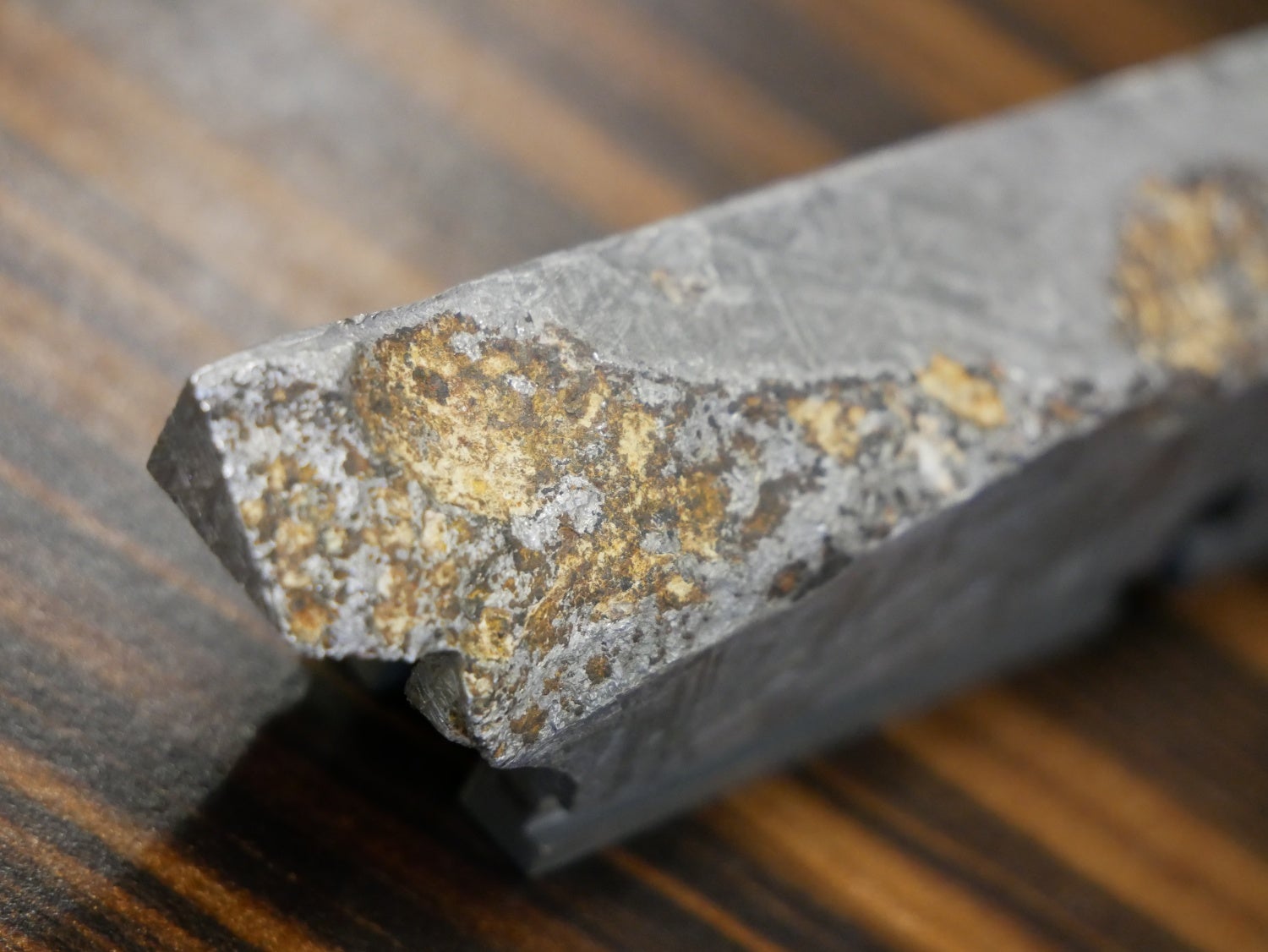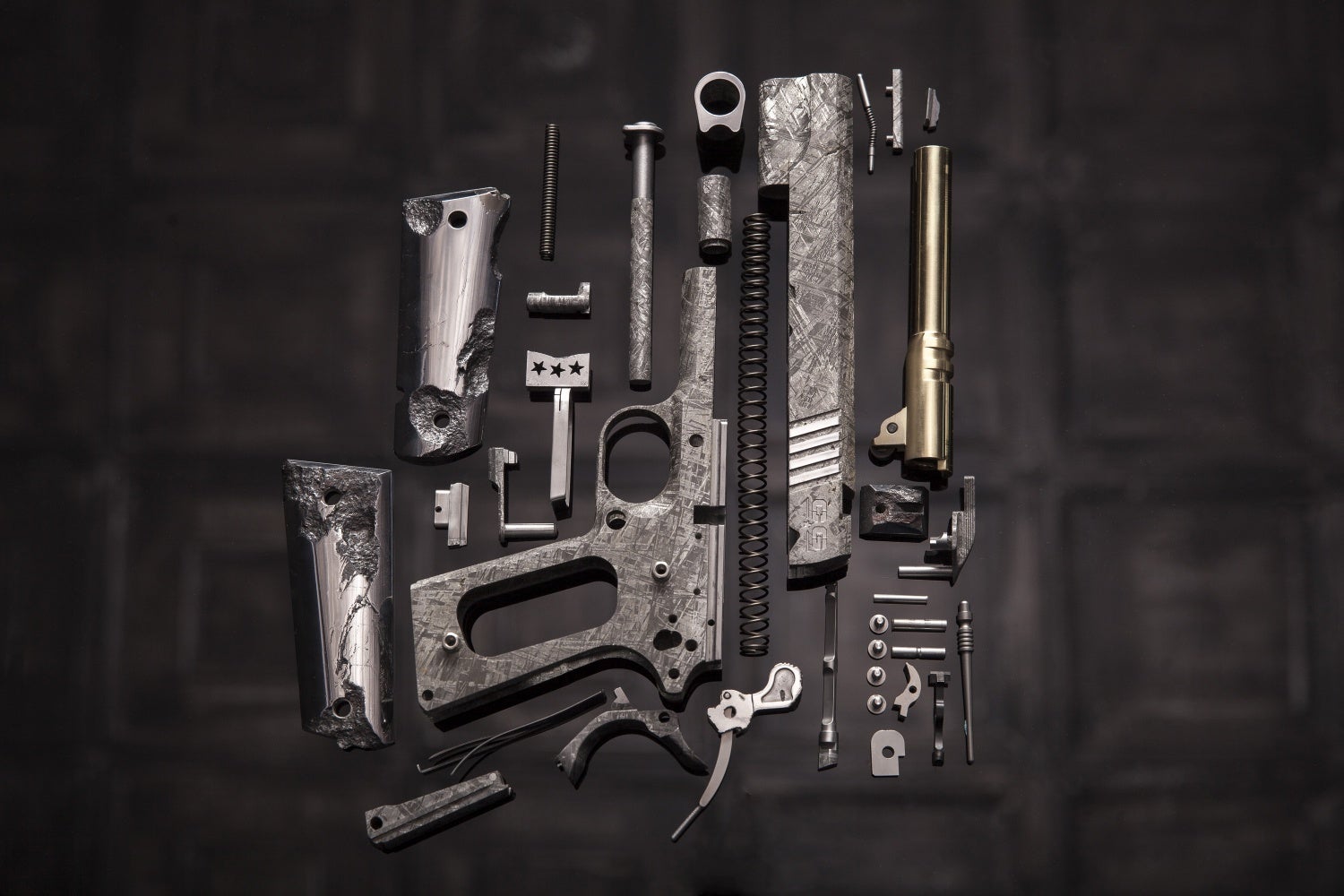Recently TFB was able to sit down with Rob from Cabot Arms and conduct an in-depth interview about the odd meteorite 1911 pair that they created, but also more about the founding the company itself. Nick C. was also present during this interview and was instrumental in asking questions. Some of the photos shown here are not of the pair of meteorite 1911s, but instead of the Time Traveler 1911, which used material from the same metorite that Cabot bought for the meteorite 1911.
The Firearm Blog- Tell us about founding Cabot.
Cabot- I’ve always had an interest in high precision engineering and manufacturing. I have some familiarity with it, but that isn’t my background. But transitioning to firearms, if you wanted the finest shotgun in the world, it kind of pissed me off that I would have to go to London and purchase a Boss or a Purdey. Firearms are supposed to be a truly American thing right? Not only important as an object but also with the history as to what this country is all about. And to me, it seems that industry has gone to the lowest common denominator, how do we make this extremely cheap and efficient… But at the same time, we do have extraordinary skillsets here that are capable of so much more. So when I launched Cabot in 2011 I didn’t think it would be a business. Initially it was just an after work thing to sell nice guns among my friend group. But we debuted very quickly and I thought after 6 months, maybe we could turn this into a business. So I gave myself two years to get to a breakeven point. If it became profitable we’d carry on, and if not, we’d close shop.
TFB- And you got into 1911s?
Cabot- Yes, and in learning about the 1911 I was kind of shocked that we are still making them, essentially the same way we made them one hundred years ago. Not that there is anything wrong with that approach, but there are precision capabilities that we have now that didn’t exist back then. So I knew those kinds of tight tolerances were out there, especially once you developed the right specifications out of the gate. The idea was to make a gun that was mechanically state of the art in the construction. I wanted a gun that looked good too as I’ve always liked beautiful things. We worked with all the local shops in this area of Pennsylvania. There are some excellent resources here for the tool and die industry which is very high precision work, everything from aerospace to progressive die components.
TFB- What brought you to this part of the ountry to to begin with?
Cabot- I was here in the area, familiar with people in the various trades and had connections. I knew it could be done and thus started on some prototypes. By virtue of building that way though, it wasn’t cheap. Initially the guns cost several thousand dollars to build and everyone was telling me, “Rob, no one is going to buy a gun for five thousand dollars”. Now, I’ve always been a data-driven guy as in what is the case study, where is the market research, who has done what. But there wasn’t really a 1911 company out there that had previously done exactly what we wanted to do. I knew there was a high-end luxury market for guns and I was operating on the premise of “Well, if you like guns, and you can afford a nice watch, then you can probably afford a nice gun too”.
TFB- Let’s talk about the Meteorite 1911s…
Cabot- Something we really pride ourselves on here at Cabot is our emphasis on working with a wide array of materials. I tried to push the envelope to see what is possible, aesthetically, price point, material supply. We had already worked with some really high-end materials by that point. Previously we had done a Damascus gun and this was the first handgun that had a Damascus slide. In addition to some actual prehistoric mammoth molar bone for grip panels. I do a bit of traveling and do a lot of handpicking and during one of these trips I changed upon working with meteorite to create a set of grips with. When we put it on the gun I remember thinking, “This must be the coolest thing I’ve ever held”. To me it encapsulates so much. You think of a gun as an object and then think of life, mortality, and time. So holding something as old as a meteorite seems to embody many of those concepts in a way.
TFB- Meteorite it was then?
Cabot- Well I was with my business partner after a trade show where we were discussing what sorts of approaches could we take to increasing our branding and setting ourselves apart in the industry. Engraving? It’s been done. Intrinsic value? There are some excellent alloys out there, but if you did them right, no one would know what they actually were and could appreciate them. It had to be something recognizable and totally unique. Throughout coming up with ideas, we remembered the meteorite grips and pondered about making an entire handgun out of it. Thinking about it more, it actually sounded like a good idea. We started learning about all the types of meteorites out there and realized we had to acquire the perfect piece of material to build a gun from. And I tell you, the guys who trade in meteorites are the most eccentric bunch of people you’ll ever meet. They aren’t PhD Astrophysicists but they are obsessed about meteorites in space. When you meet them, you just realize how much of a character they can be.
TFB- The search ended with the perfect meteorite.
Cabot- After a number of months indeed it did, we found and identified exactly what we were looking for. Now we couldn’t just pick any meteorite on the collectors market. It had to be an iron meteorite, which makes up around 3-4 percent of all the meteorites available. The theory is that these come from the cores of a planet’s most dense matter that collided with each other during the Big Bang. So there is a small number of iron meteorites, but even within that population, the properties can change significantly. Even within chunks you have variability. The same way you judge a precious stone, you have to judge some of the purity, consistency, characteristics, as well as the aesthetic qualities. The Gibeon meteorite was certainly the most prestigious of the iron meteorites out there that have been known or been used. We knew from a collectability standout of intrinsic value, that was the Cadillac of meteorite material.
TFB- Was there any process to know for sure what you were buying, instead of ending up with a chunk of rock from some hillside?
Cabot- That goes into the vetting of who you are buying from. As a newbie to the meteorite market, we did have to rely on the providence of the seller. Now I’m at the point that I can tell what the composition of a meteorite probably is by looking at the patterns in it. But essentially you’re paying a ton of money for what is really just another rock.
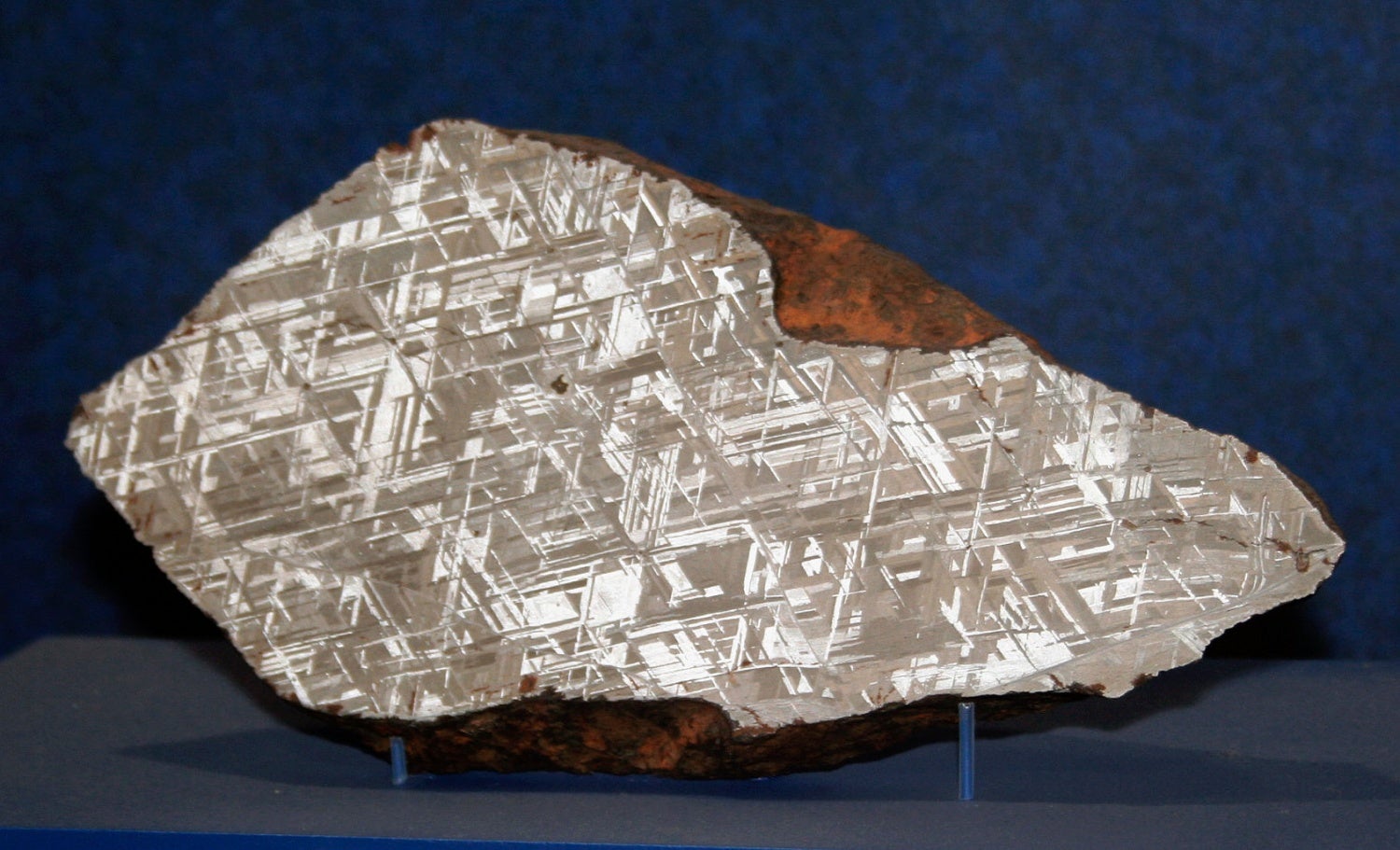
A bi-sectioned meteorite. Note the long striations inside the rock, also known as Widmanstätten patterns or Thomson structures. You see the same patterns on the meteorite materials used in Cabot guns and knives. The striations are unique to meteorites and aren’t found in any other rock that hasn’t fallen to Earth. Image from Wikipedia Commons.
TFB- Thus began the process of turning a meteorite into a gun.
Cabot- It all happened at our facility in Fort Wayne, Indiana where we assembled an excellent group of guys to work on it. My partner has a Master’s in Engineering, very smart technical guy. My other chief technical guy owned a very successful aerospace company for 30 years. We also have a had a good tool maker, two good machinists, just a large amount of talent and background we could pull from in order to bring the idea to reality. But the key was how do you make something that not only looks like a gun, but withstands the correct pressures resulting from firing it. Because it’s not perfectly homogenous material that we were working with.
TFB- It was just the slide and the frame right?
Cabot- No, not at all, the overwhelming majority of the parts were all from the meteorite. In the beginning we were hoping to make one gun, but we ended up in making a pistol set which is a right and left handed 1911. The left-handed pistol was completely inverted with the safety, magazine release, ejection port, and extractor. So the first part was like, okay great, we have this chunk of space rock. We 3D scanned it, put it in CAD. Once we had smaller slabs we were able to do X-Rays as well. Then we had to cut out pieces of billet for every component. Then we need a Plan B, because you could easily cut out a section and find out you have a hollow space where you thought it was solid. That alone caused a lot of anxiety, because what do you do, you’ve already committed so much by this point in time.
TFB- How big was the rock?
Cabot- It was about 35 kilograms, around 77 pounds. The first cut we did was with an EDM wire which would work out great until we hit an inclusion and then our wire would be burnt. I think it broke about 100 times just cutting the rock in half. When it came open, it was perfect inside, so that was solved. But then it becomes an engineering exercise to create actual components that we could assemble a 1911 from. Impact components versus non-impact components, looking at where the stress areas are. We had a lot of big pictures problems to solve but also a number of smaller picture problems as well. The big issue was that it was iron based and how do you make a mechanical object that isn’t going to goll, or stick together when the surfaces are supposed to move against each other, but yet is strong enough to withstand the pressures of a .45 ACP round. That was the sixty-four dollar question. One of the answers we had to this was a EBW process. It comes down to being a small particle accelerator and is one way you can fuse perfect alloys together, pretty fascinating stuff. There were also a number of components that were bimetal, part meteorite and part steel. For example, items like the slide stop, the pin that goes through it is steel. Every component had to be reviewed, stuff like the ejection port side you want make that a little bit larger, little bit higher to have more material to work with. Then we built clone components. Each part had a clone component that was harder and another one that was softer. This was so we could test how it would withstand impacts throughout different ranges. The process was such that every single part had to be looked at from an engineering standpoint.
TFB- Anything different for the slide because of the heavy stress impacts on it?
Cabot- No, nothing at all, the slide is iron, it’s from the meteorite.
TFB- What about the aesthetics?
Cabot- We had to be very artful and strategic with the pieces that were exposed. On the grips for example we wanted to show the “bark” of the meteorite. For this we wanted to show the different elements and patterns that were present in the rock. Precisely because many of these metallurgic patterns don’t occur anywhere else in nature but in meteorites. The theory is that after these planetary systems collided, the slow cooling of a few degrees every million years produced these intense patterns. Every million years! In addition to the patterns on the outside created by crashing through the Earth’s atmosphere. But that’s what we did, piece by piece, component by component, every step of the way was a science experiment. We went into it thinking it would be “X”, but instead it was “X” times five or six.
TFB- And test firing this mega million handgun?
Cabot- We put it in a rest and shot it from behind a ballistics shield but I remember thinking, “If this breaks in half…”. It probably wouldn’t have killed us financially, but it would have been a huge loss for sure. This is why we didn’t say anything about it until we had a high degree of confidence that it would work. After we shot it a number of times, it was quite obvious that you could shoot it all day. But the initial test fire was certainly very nerve-racking.
TFB- Finally, the meteorite 1911 is ready to go. What next?
Cabot- December 2015 was when we announced the handgun to the media in a press release. And we get crickets…absolutely nothing. We were really disappointed at first. But then around Christmas time I got an email from CNN asking a couple questions about it. They ran a small piece on it and the next two weeks after that it just exploded and it went everywhere. It mushroomed between there and early January. I remember seeing on a trending column, the new Star Wars movie, Mark Zuckerberg, and then our meteorite gun. That whole month I got calls from writers all over the world asking about it, just unbelievable. In terms of making us global and unique it far surpassed my expectations. We never could have bought or spent money to get that kind of exposure any other way.
 Your Privacy Choices
Your Privacy Choices
